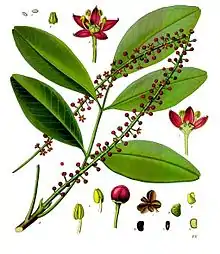Pilocarpus
Pilocarpus is a genus of about 13 species of plants belonging to the family Rutaceae, native to the Neotropics of South America. Various species are important pharmacologically as a source of the parasympathomimetic alkaloid Pilocarpine.[1] Many of the species have the common name jaborandi.
| Pilocarpus | |
|---|---|
 | |
| Paraguay Jaborandi (Pilocarpus pennatifolius) | |
| Scientific classification | |
| Kingdom: | |
| (unranked): | |
| (unranked): | |
| (unranked): | |
| Order: | |
| Family: | |
| Subfamily: | |
| Genus: | Pilocarpus |
| Species | |
|
See text | |
Etymology
The taxonomic name Pilocarpus is derived from ancient Greek πῖλος wool, felt + καρπός fruit.
Species
- Selected species
- Pilocarpus jaborandi (Pernambuco jaborandi)
- Pilocarpus microphyllus (Maranham jaborandi)
- Pilocarpus racemosus (Guadeloupe jaborandi)
- Pilocarpus pennatifolius (Paraguay jaborandi)[2]
- Pilocarpus spicatus (Aracati jaborandi)
References
- De Abreu, Ilka Nacif; Sawaya, Alexandra Cristine H. F.; Eberlin, Marcos Nogueira; Mazzafera, Paulo (November–December 2005). "Production of Pilocarpine in Callus of Jaborandi (Pilocarpus microphyllus Stapf)". In Vitro Cellular & Developmental Biology. Plant. Society for In Vitro Biology. 41 (6): 806–811. JSTOR 4293939.
- Chisholm, Hugh, ed. (1911). . Encyclopædia Britannica. 15 (11th ed.). Cambridge University Press. p. 104.
External links
This article is issued from Wikipedia. The text is licensed under Creative Commons - Attribution - Sharealike. Additional terms may apply for the media files.